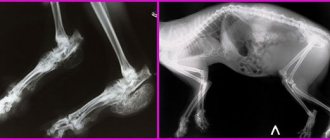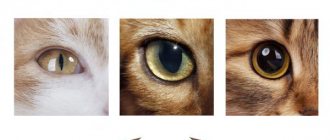The method of treating various diseases with the help of animals has been practiced for a long time. One of its areas is feline therapy - the effect of cats on the physical and psychological state of a person. Not everyone believes in the effectiveness of this method, but there are many examples of its successful use.
Felinotherapy is treatment with the help of cats. Communication with furry pets has a positive effect on humans and can alleviate symptoms of some diseases. This method can also be used to prevent nervous and mental disorders, and disorders of the cardiovascular system.
What is felinotherapy
Even in ancient times, people noticed that in the presence of cats their well-being improves and their mood improves. These animals were deified and believed in their supernatural power. Many cat owners note that they feel the person’s condition and often try to lie down on the sore spot.
Modern research by scientists has determined that the biofield of cats has a beneficial effect on humans. Studies have proven that after communicating with these animals, the condition of patients with cardiovascular diseases improves, the healing of injuries is accelerated, and they have a positive effect on the mental state.
Cats help with dementia and Alzheimer's disease
The presence of a cat has been shown to improve attention, communication and empathy in older adults with dementia.
The Catalina Springs Memory Care nursing home in the US state of Arizona several years ago began a special project: residents of the facility with Alzheimer's disease cared for stray kittens from a local shelter.
The kittens had to be bottle-fed several times a day. Although there were initial doubts about the positive outcome of the study, whether people with memory problems would be able to cope with this task, these elderly people did succeed in caring for helpless creatures.
The effectiveness of feline therapy
It has been noticed that in families where cats live, people suffer from fewer colds and sleep better. Cats help to recover from drug addiction, panic attacks, and neuroses. Communication with them is effective even with severe depression and schizophrenia.
There are many positive results of feline therapy for children with congenital neurological and mental pathologies. Autistic people who live in the same house as a cat are more open and calm. Pets help them establish contact with the outside world. Elderly people feel better because the animal brightens up their loneliness.
Felinotherapy performs the following functions:
- psychophysiological – increases resistance to stressful situations;
- psychotherapeutic – helps to establish contact, calms;
- increase the feeling of significance, need and worth, this helps in the fight against depression and suicidal behavior;
- strengthen the desire for self-realization - often caring for cats helps a person cope with an illness;
- cats compensate for the need for communication and help to forget about loneliness.
Healing cats for children
Children especially benefit from animal-assisted therapy. For example, autistic children often have difficulties with interpersonal communication. They tend to interpret statements literally and have difficulty interpreting people's feelings.
Cats accept little patients as they are. They are alien to ambiguity, hidden motives and irony. They convey their feelings directly. These qualities make it easier for children to understand and help them open up.
Therapy cats are also used to treat children suffering from attention deficit disorder (ADD). Cats help them stay calm and focus.
What effect do cats have on humans?
Cats influence humans in different ways.
- Purrs are sounds with a frequency of 20-50 Hz. They are pleasant and relaxing. These sounds accelerate regeneration processes and strengthen the immune system. Even not direct communication with the animal, but listening to the purring speeds up recovery from various diseases.
- A cat's body radiates heat, since its normal temperature is 3 degrees higher than that of a human. This is useful for joint diseases, after injuries. After the cat lies down on the sore spot, the person’s condition improves and it is easier for him to relax.
- Since ancient times, people believed that cats take away negative energy from humans. Research by modern scientists has proven the existence of energy exchange with animals. His biofield really has a positive effect on people.
- Cats often shift their paws from place to place, sometimes releasing their claws. This is a kind of massage with acupuncture functions, which also has a healing effect.
- Petting your cat helps eliminate static electricity. This is beneficial for people with high blood pressure.
- Communication with a furry pet helps you calm down, relax, and improves your mood.
Cats as therapy animals
Psychotherapists see an overall very positive impact of animals on patients with mental illness. For example, dogs, horses, dolphins and alpacas are used in animal-assisted therapy. Cats are also becoming increasingly popular as pet therapists. Because of their delicate nature, cats have the ability to soothe the soul.
Cats have a calming effect on many patients just by their presence. A kitten calmly curled up on the couch in a therapy room helps reduce a patient's fear and build confidence.
Photo: Pixabay
Cats also serve as icebreakers—conversations are easier to navigate when therapist and patient can first talk about the animal in a relaxed environment. After such a pleasant introduction, there is a much greater chance of tackling painful, difficult topics for the patient.
Feline therapists have proven particularly beneficial for patients with anxiety disorders, depression, and post-traumatic stress disorder (PTSD).
What diseases do cats help treat?
Felinotherapy will not help cure serious diseases. But as an auxiliary method to relieve symptoms and speed up recovery, it can be used for the following pathologies:
- neuroses;
- depression;
- insomnia;
- chronic fatigue;
- anxiety;
- schizophrenia;
- alcohol and drug addiction;
- autism;
- radiculitis;
- arthrosis;
- osteochondrosis;
- hypertension;
- cardiovascular diseases;
- tachycardia;
- renal and liver failure;
- colds, ARVI;
- pneumonia;
- pain syndrome of different localization, even with oncology.
Therapy differences
The Corson couple from the University of Ohio (USA), working closely with the University of London to popularize the Psychotherapy with Pets program and implement it for the treatment of mental disorders after head injuries and strokes.
The purpose of the work: to find out whether a complete recovery of the patient is really possible, and what is the percentage of improvements in the state of the brain and consciousness after prolonged contact with animals.
This was already the 20th century, and scientists could use sensors for determining high and low frequencies, which were used to determine the level of the brain’s reaction to external stimuli. The sensors were, of course, tuned to the frequency of the human brain, but they were connected to a generator that created an electric field. During one of the sessions, a cat entered the laboratory (the animals could move freely) and... the sensors simply “went crazy”! Having measured the electromagnetic field of the cat, scientists were surprised by the indicators: they no longer needed a generator - the cat “produced” a field of greater magnitude and lower frequency.
Colleagues in London were just trying to cure chronic inflammatory diseases using low currents, involving other animals in their work.
A report on the low-frequency field created by a common house purr was immediately sent to the UK. They took this message seriously and conducted a series of tests with cats, dogs and people. In order not to bore you with a long retelling of the experiments themselves, we note the main thing: a cat, during the treatment process, absorbs a lot of energy from a person, and a dog gives back its own.
Both the dog and the cat accurately find sore spots; apparently, they recognize these spots in the same way. Each human organ has its own color spectrum and frequency radiation. When an organ is damaged, both the spectrum and radiation are disrupted.
Since neither a dog nor a cat has color vision, it is logical to assume that it is electromagnetic radiation that influences their choice.
And then everything happens differently. The dog tries to “wrap up”, “hide”, “lick” the diseased organ, making every effort. The cat, on the contrary, “sucks” the pain out, as if drawing it into itself.
Cat therapy is similar to the actions of a surgical instrument - a cat treats a person, eliminating the disease, “taking” it into itself.
Canine treatment is close to rehabilitation after surgical intervention - relief and recovery.
This is the main difference between canisterapia and felistherapia.
How is the treatment carried out?
Communication with a cat should take place in a calm, comfortable environment. It is desirable that both the person and the animal are interested in contact. It should be natural, you should not force the cat to come. These animals are independent and do not like coercion. They often feel that a person is sick and try to help.
A session can last from 10 minutes to several hours. It depends on the mood of the person and animal, on the well-being of the patient. Usually the course of treatment lasts a week, but after that you can continue to communicate with the cat. It is not necessary to have your own pet for this; not everyone is ready to take responsibility for the animal.
Felinotherapy methods
There are several methods of feline therapy. Usually a non-directional method is used, where the cat lives next to the person and heals him. In this case, the animal chooses when to approach the person and does not impose itself. Such constant communication has a positive effect on the condition of patients.
The semi-directed method is used when a person does not want to communicate with the animal. This happens, for example, in children with autism. But watching other people pet cats and play with them, the child makes contact faster. In this case, it is better to use specially trained animals that understand when to approach the patient.
If a person willingly communicates with cats and loves them, a targeted method of feline therapy is used. It uses not only the animals themselves, but also their images, figurines, and a recording of purring.
Cats heal their owners. Did you doubt it?
Contents hide
Cats heal their owners. Did you doubt it?
Hey, dear fellow cat lovers! And also those who are just taking a closer look and seriously considering cats as potential pets! Today we are going to bring balm to your hearts and talk about the undeniable health benefits that come with owning a furry pet. No idle fiction, friends! Only the facts brought together by our British colleagues.
Cat owners experience far fewer heart problems. There have been many studies on this topic, and they have all clearly shown that the heart of cat people works more “steadily.” Scientists from the University of Minnesota recently discovered a pattern: by owning a cat, you reduce your risk of dying from a sudden heart attack or stroke by 30-40%. Let us emphasize that the cat purrs at a special frequency, which probably contributes to the speedy healing of our heart wounds. Both literally and figuratively!
Cats stabilize blood pressure. It's simple: if you suffer from arterial hypertension, be sure to call and pet your cat. Your humble servant, in particular, decided to experiment: everything really works! Why is that? Hard to say! Perhaps it is the general calming effect of regular communication with the cat.
A cat is a great cure for loneliness. It is not without reason that it is believed that the absence of a cat in the house makes it empty and lifeless. As the wise English say, “the cat rules the house”! These animals are wonderful companions and patient listeners. Recently, Swiss scientists confirmed that a domestic cat is akin to a partner in a relationship. Most of the lonely cat owners interviewed confirmed that their pets always understood them and helped them cope with loneliness and problems. In addition, communication with cats helps people smooth out the bitterness of loss during days of deep mourning.
Cats can relieve stress and anxiety. Are you plagued by some intractable problems? No problem - pet the cat. Let her sit next to you and purr. Scientists still have little idea how everything happens, but this is an indisputable fact. In addition, cats spray special volatile chemical compounds around themselves. They also help relieve stress and anxiety!
Cat owners sleep better and deeper. Do you have a cat? Then you probably don’t know what sleep disorders are. Again, why? Science does not provide a reliable answer to this question. But experts from the Mayo Clinic Center for Sleep Medicine have proven that having a cat in the house improves the quality of sleep in as many as 40% of cases. Of course, now all those who have furry pets that keep them up at night have shrugged their shoulders: they travel throughout the body, settle in their heads, etc. But cats give warmth and purr so inspiredly!
Cats improve immunity. It sounds like science fiction, but scientists have proven that owning a cat helps strengthen the immune system in people! The main thing is that living next to a cat always brings happiness and a sea of positive emotions, and this is precisely an indispensable condition for maintaining immunity! And for starters, a fact known to our regular readers: if your child has interacted with the family pet almost since birth, the likelihood that he will suffer from allergic disorders and asthma in the future is reduced to a minimum.
Cats actively fight depression. Clinical depression is a disease that requires qualified medical care. And cats are unlikely to help in this case. But furry friends can cope with mild bouts of blues and depression with all five points! There is only one recipe - pet the cat!
Cats make their owners healthier. What do we mean? Of course, not all cats will allow you to put a collar on them and invite their owners to go for a walk, just like dogs. We know that movement is life! But who said that you only have to move along the street? Try, for example, to do a general cleaning of your home, clearing things, objects and clothing from the cat hair that has stuck here and there. How many kilocalories will you spend on this? The fitness room is nervously smoking on the side...
Cats can help cope with autism in some cases. You and I know that specially trained dogs work effectively with children with autism. But science also knows other cases where cats helped sick children enter our large and complex world. And “specially trained cats” - doctors also exist! Only, unfortunately, less is known about them.
A cat may one day save your life. And even so! The world knows several shocking stories when tailed pets saved the lives of their owners in critical situations. Thus, one British miracle cat always warns about the onset of an epileptic seizure in its owner. Another cat, this time in the United States, managed to wake up its owners after sensing a domestic gas leak from the pipes. Similar examples can be continued! Cats have a phenomenal sense of impending danger and know how to give signals to their owners.
Here we have such an interesting article. You can exhale, dear cat lovers! After all, you already knew all this, or at least guessed it. Finally, let’s say with a feeling of deep confidence: our cats are the best in the world!
Quoted from: . Photo: pixabay.com
What cats are used in feline therapy
Any cat is suitable for feline therapy, the main thing is that they are not aggressive and make contact. The animal must be mature, friendly and calm. It has been noticed that cats do not even need to be trained to communicate with sick people; they instinctively find an approach to special children and independently identify the sore spot.
Felinotherapy has not yet been studied enough. But observations of people and research by scientists have made it possible to determine that different cats do not help in the same way with certain pathologies. Psychologists recommend choosing the breed and color of the animal. Although the main thing is his character and temperament.
Cats and kittens are equally suitable for treatment. Only the animal should be calm and affectionate. But it has been noticed that cats are better at treating mental and neurological disorders, and cats are better at relieving pain. It is recommended to use unsterilized cats and non-neutered cats, they have stronger energy.
Breed
It is believed that the cat breed influences the effectiveness of feline therapy:
- Siamese are better at treating diseases of the digestive and genitourinary systems;
- long-haired dogs (Angora, Persian) cope well with radiculitis, arthrosis, and also help with depression and nervous disorders;
- Siberian cats get along well with children, helping them become calmer and improve communication skills;
- British and Russian Blues are more suitable for treating diseases of the cardiovascular system;
- sphinxes help women with gynecological pathologies;
- Maine Coons help with nervous disorders and autism.
Color
The color of the animal's coat can also affect the effectiveness of treatment. Psychologists have long studied the influence of color on a person’s emotional state. Observations and experience of using different cats allows you to choose the right coat color of the animal to increase the effectiveness of feline therapy.
- Black cats make contact better and have strong energy. They help in the treatment of severe mental disorders and neuroses. It is believed that black wool absorbs negative emotions well.
- White cats help get rid of depression and relieve fatigue. This color gives positive emotions and calms.
- Cats of red and cream color charge you with energy and good mood. Communication with them gives strength and eliminates fatigue.
- Colorful cats relieve stress and lower blood pressure. And the color-point color, in which the muzzle and paws are darker against the background of a light body, helps to recover faster from colds.
The magical power of purring
Scientists have been studying such an amazing cat ability as purring for many years. Purring is a powerful healing tool that helps your cat be resilient and in good health.
- There is a whole section in cat therapy that is dedicated specifically to purring.
- These sounds help people heal faster, and nothing is as calming as a lurking, purring cat.
- When a person hears these sounds, his blood circulation improves, his heart rate and blood pressure normalize.
Cats absorb negative human energy, converting it into positive impulses.
How to increase the effectiveness of feline therapy
The effectiveness of feline therapy will increase if you follow several rules.
- You need to choose the right time. Treatment is usually carried out in the evening. But morning is more suitable for getting rid of some diseases.
- If possible, you need to choose the right cat color, coat length and breed. Depending on the disease, the sex of the animal is also selected.
- It is desirable that communication with the cat be daily and pleasant for both. A person must love animals and show respect for them. Cats feel respect for themselves. Under no circumstances should you force her or force her into your arms if she is not predisposed to communication.
Contraindications to cat therapy
Is it true that cats heal? Scientists were able to prove this, but are there indications for this type of treatment? Often, cat therapy is suitable for almost everyone, but if a person is allergic to cats or simply dislikes these animals, then it is better to refuse such an idea.
Also, you should not contact cats during an exacerbation of mental illness; the animal will simply get scared and will not be able to help the person in any way.
There are very few contraindications to cat therapy, so every lover of these cute and fluffy creatures can take advantage of their healing properties and feel the magic of their beloved pet.
Contraindications for treatment in cats
Not all people are suitable for feline therapy as a method of treating and preventing diseases. It should not be used for those who do not like cats, have a dislike or fear of being scratched. There are also several cases where this method can be harmful:
- allergy to animal fur;
- open wounds on the body, serious dermatological diseases;
- severe mental disorders.
Felinotherapy is being studied by science and has already been proven to be effective. Although it cannot be an independent method of treatment, it is usually used for prevention or to alleviate the patient's condition. The main advantage of this method is its accessibility. Anyone can have a furry pet. The main thing is to love cats, take care of them, then they will reward you with affection, lift your spirits and help you recover.
How does a cat treat its owner?
Domestic cats heal people, causing a lot of positive emotions with their appearance and behavior. The patient, seeing such cuteness, relaxes, forgets about pain and discomfort. It is in a positive attitude that the maximum healing effect is achieved. Men and women who have cats at home are much less likely to suffer from various diseases. If the pets feel that something is wrong with the owner, he is sick and experiencing discomfort, the animals immediately provide first aid. They lie opposite the diseased area and take away negative energy. Thanks to this effect, a person can recover faster at home, without resorting to traditional medicine.
Cats give women women's health
All over the world, doctors are inclined to say that a woman cannot be considered completely healthy if she does not have any diseases. A completely healthy woman, among other things, should have excellent health and mental well-being, which cats cope with with a bang. Every woman and girl should think about this if she wants neither her body nor her soul to get sick. The affectionate purring, soft paws of a pet, the warmth and tenderness emanating from a cat have a relaxing and calming effect on any woman. Relax, you, weak woman, after a grueling day of work, relaxation is extremely necessary!
Mustachioed Murchiki even help women overcome pain during menopause and menopause. At this time, the cat lies down on the stomach of the owner who is suffering from pain and begins to warm her with its warmth. After this, you will feel the pain gradually leaving you. Isn’t it happiness to have a living creature in your home that responds to you with tenderness, affection, and healing effects for your constant care for it?











